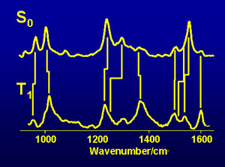| |
Normal mode analysis

Normal modes of vibration are collective oscillations of the nuclei in a molecule. A nuclear coordinate Q represents a vector of the motions of the individual nuclei (x1, y1, z1, x2, y2 z2, etc.). The nuclei all pass through the equilibrium configuration simultaneously, but they move in different ways on either side of the equilibrium. Normal modes are calculated as the eigenvectors that arise from the diagonlization of the force constant matrix for individual nuclei. This procedure is description in the presentation on Normal Mode Analysis. Quantum chemistry codes output these eigenvectors, which can be used to generate pictures of the normal modes and for calculation of potential energy profiles that have application in any consideration of coupling to nuclear vibrations. For example, by plotting the motions calculated from a code one can determine whether there is single mode anharmonicity or multi-mode anharmonic coupling. One can also determine the ground and excited state minima for the normal modes, which is used in the calculation of Franck-Condon factors from first principles.
The Wilson FG Matrix approach
Applications of symmetry to the calculation of normal coordinates was essential before the advent of teh computer. It is still a useful exercise since it gives one insight into the factors that govern normal coordinates.
Spectroscopic examples
- Metalloporphyrins
- Nucleic acids
- Proteins
| |
|
|
|